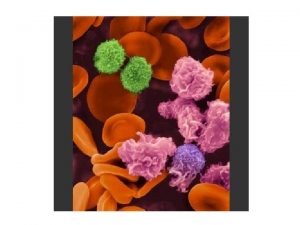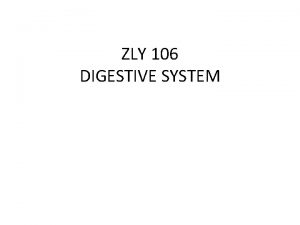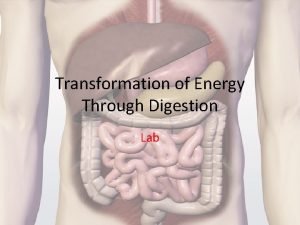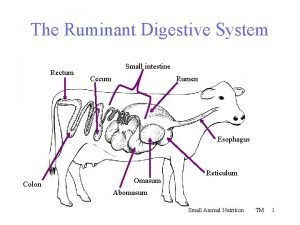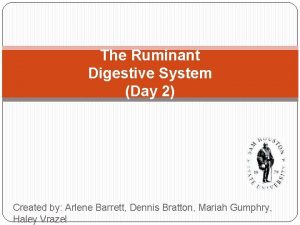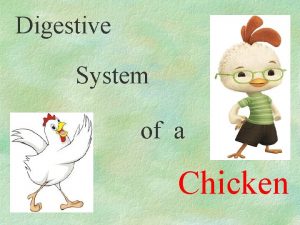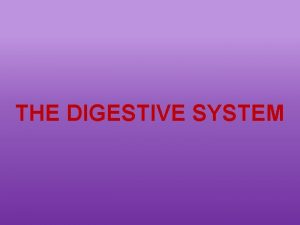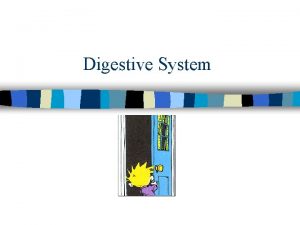Lecture 21 Digestive System I 1 Digestive System














- Slides: 14

Lecture 21 Digestive System I 1

Digestive System Anatomy • Digestive tract – Alimentary tract or canal – Gastrointestinal (GI) tract • Accessory organs – Primarily glands – Liver, gallbladder, pancreas, salivary glands • Regions Fig. 26. 1 – – – – Mouth or oral cavity Pharynx Esophagus Stomach Small intestine Large intestine Anus 2

Functions • Ingestion: Introduction of food into mouth • Mastication: Chewing • Propulsion – Peristalsis: Moves material through digestive tract – Mass movements: Moves material through large intestine Fig. 26. 2 3

Functions • Segmentation: Segmental contraction that occurs in small intestine • Secretion: Lubricate, liquefy, digest • Digestion: Mechanical and chemical • Absorption: Movement from tract into circulation or lymph • Elimination: Waste products removed from body Fig. 26. 2 4

Oral Cavity • Mouth or oral cavity • Lips (labia) Upper lip – Orbicularis oris Hard palate • Cheeks Soft palate Uvula Palatine tonsil Tongue Salivary duct orifices Sublingual Submandibular Teeth Lower lip Fig. 26. 3 – Buccinator • Palate: Oral cavity roof – Hard and soft • Palatine tonsils • Tongue – Involved in speech, taste, mastication, swallowing – Skeletal muscles 5

Salivary Glands • Produce saliva – Prevents bacterial infection – Lubrication – Contains salivary amylase • Breaks down starch • Three pairs Fig. 26. 4 – Parotid: Largest – Submandibular – Sublingual: Smallest 6

Pharynx and Esophagus • Pharynx Internal nares Opening of auditory tube Nasopharynx Oropharynx Pharynx – Food passes through the oropharynx and laryngopharynx Laryngopharynx Esophagus Trachea Fig. 25. 2 7

Review Question Food moves along the esophagus by (a) Peristalsis (b) Gravity alone (c) Mass movement (d) Force of swallowing (e) Contraction of ribs 8

Pharynx and Esophagus • Esophagus Oral cavity Pharynx Esophagus – Transports food from pharynx to stomach – Passes through esophageal hiatus (opening) of diaphragm and ends at stomach • Hiatal hernia Liver Stomach – Sphincters • Circular muscles • Upper • Lower Fig. 26. 1 9

Stomach Anatomy Fig. 26. 12 Fundus Esophagus Pyloric orifice Cardia Pyloric sphincter Duodenum Pylorus Openings Longitudinal layer (outer) Circular layer (middle) Oblique layer (inner) Three layers of smooth muscle Gastric folds Body • Gastroesophageal: to esophagus • Pyloric: to duodenum Parts • Cardia • Fundus • Body • Pyloric 10

Stomach Histology • Layers – Three layers of muscles • Outer longitudinal • Middle circular • Inner oblique Fig. 26. 13 11

Stomach Histology Fig. 26. 12 • Rugae: Folds in stomach when empty • Gastric pits: Openings for gastric glands – Contain cells • Mucous cells: Mucus along surface and in pits • Parietal cells: Hydrochloric acid • Chief cells: Pepsinogen Fig. 26. 13 12

Points to Remember • Digestive system consists of digestive tract and accessory organs (primarily glands) • Functions include mechanical and chemical breakdown of food, absorption of nutrients and elimination of wastes • Mechanical and chemical breakdown start with oral cavity • Food transported through pharynx and esophagus to rest of digestive tract • Stomach – Mixes food – Protein digestion – Limited absorption (aspirin) 13

Questions? 14
 01:640:244 lecture notes - lecture 15: plat, idah, farad
01:640:244 lecture notes - lecture 15: plat, idah, farad Digestive respiratory and circulatory system
Digestive respiratory and circulatory system Nervous system and digestive system
Nervous system and digestive system Power system dynamics and stability lecture notes
Power system dynamics and stability lecture notes Operating system lecture notes
Operating system lecture notes Zline 667-36
Zline 667-36 Unified health management information system
Unified health management information system Lymphatic system outline
Lymphatic system outline Power system dynamics and stability lecture notes
Power system dynamics and stability lecture notes Sheep ruminant digestive system
Sheep ruminant digestive system What is this
What is this Digestive system energy transformation
Digestive system energy transformation Conclusion of digestive system
Conclusion of digestive system Ruminant digestion
Ruminant digestion Ruminants fourth stomach
Ruminants fourth stomach







